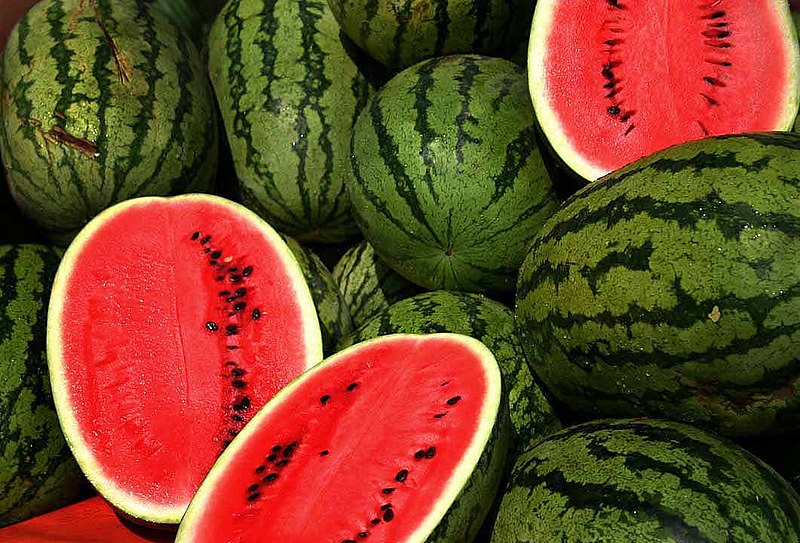Growing Watermelon in the Home Garden
History
Africa is considered to be the native home of the watermelon. It was found growing wild by Livingstone in 1854. On the American continent, watermelons were grown as early as 1629 in Massachusetts, and prior to 1664 in Florida.
 Climate
Climate
The watermelon is tender to frost and requires a long growing season with relatively high temperatures. Daytime temperatures between 70 and 80 degrees F and nighttime temperatures between 65 and 70 degrees F are ideal. Watermelons grow well in both humid and semi-arid areas, but foliar diseases are less destructive in drier climates.
Fertilizer and Lime
Fertilizer applications are best based on soil test results. Soil sample bags, forms, and instructions are available from your county Extension office. General recommendations, when using black plastic mulch, would be one pound of actual nitrogen, two pounds of phosphorus (P2O5), and three pounds of potash (K2O) per 1,000 square feet. On bare ground, increase the amount of nitrogen by 25 percent. This would best be done as a sidedress application when vines begin to run. Application of lime is less important for watermelon than muskmelon or cucumber, since watermelon will tolerate a pH from 5.0 to 6.8. Growth is actually best in a pH range of 6.0 to 6.8.
Culture
The use of black plastic mulch will conserve moisture, suppress weed growth, and assist in an earlier harvest by warming the soil. Plants or seeds should be spaced two to a hill, three to four feet apart, on the strips of plastic placed on five foot centers.
Watermelon plants may be purchased or started in peat pots or pellets about four weeks before the anticipated planting time. Because watermelon plants are very sensitive to freezing temperatures, they should not be set out until all danger of frost has passed. Watermelons may also be direct-seeded through holes cut in the plastic, but this may delay harvest.
Varieties
Watermelons are available in many sizes, shapes, and colors. The shapes vary from round to oblong, with colors ranging from light green to almost black. The fruit skin color can be solid, striped, or marbled. The edible portion of the flesh can be yellow, pink, pink-red, bright red, or deep red. An additional choice of seeded vs. seedless is also available. Actually, while most of the “seeds” are thin, whitish, edible structures, there may be a few normal appearing seeds. Here are some recommended cultivated varieties, or “cultivars”, grouped by flesh color:
Red
- Madera
- Fiesta
- Oasis
- Royal Sweet
- Starbright
- Crimson Sweet
- Summer Festival
- Royal Charleston
- Sugar Baby (ice box type)
- Sweet Favorite
Yellow
- Sunshine
- Yellow Baby
- Yellow Doll
- Golden Crown
Seedless (hybrid triploid) cultivars worthy of trial are:
- Hybrid 313
- Triple Sweet
- King of Hearts
- Queen of Hearts
- Crimson Trio
- Scarlet Trio
- Tiffany
(Home gardeners should recognize that hybrid triploid watermelons are more difficult to grow than seeded types.)
Insects and Diseases
Cucumber beetles, aphids, mites, Fusarium wilt, anthracnose, alternaria leaf spot, and gummy stem blight are some of the potential problems in watermelon plantings. Some cultivars are resistant to some diseases. Contact your county Extension agent for current control recommendations.
Pollination
Home gardeners sometimes wonder why the earliest watermelon blossoms do not set fruit. The first flowers developing on the vines are male or pollen-bearing flowers. Only the female, or pistillate, flowers are capable of developing into fruit. Honey bees are the most effective pollinators of watermelon blossoms. Every effort should be made to protect the bees during the flowering period to ensure high-quality fruit.
Harvesting
Some experience is required to harvest a watermelon at its peak of perfection. As a watermelon ripens, the ground spot changes from pale green or white to cream or yellow. The tendrils near the fruit stem will dry and turn brown. The sound of a watermelon, when thumped with a finger, is a muffled, dull tone if it is ripe. An immature fruit will thump with a clear, metallic ringing tone. .
The author gratefully acknowledges James D. Utzinger, William M. Brooks, and E.C. Wittmeyer on whose original fact sheet this is based. This fact sheet was reviewed by Eugene Wittmeyer, professor emeritus, The Ohio State University, Department of Horticulture, and Marianne Riofrio, Extension Associate, The Ohio State University, Department of Horticulture.
